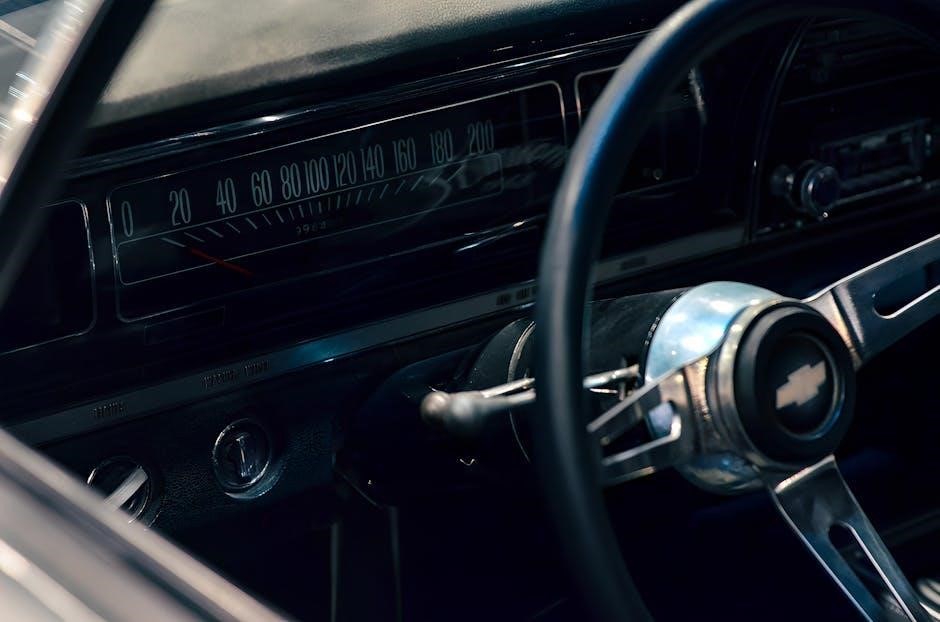5 vs 6 speed manual

Manual transmissions provide drivers with precise control over gear shifts‚ offering enhanced performance and efficiency. A 5-speed transmission delivers reliable acceleration‚ while a 6-speed adds an extra gear for improved fuel economy and smoother shifting‚ especially at higher speeds.
1.1 Overview of Manual Transmissions
A manual transmission allows drivers to manually select gear ratios using a clutch pedal and shift lever. It consists of a gearbox with a set number of forward gears and reverse. The driver must press the clutch‚ shift gears‚ and release the clutch smoothly to maintain control. Manual transmissions are known for their fuel efficiency‚ lower weight‚ and driver engagement compared to automatics. A 5-speed transmission offers five forward gears‚ while a 6-speed adds an extra gear for better performance and efficiency. Both systems provide precise control over acceleration and speed‚ making them popular among driving enthusiasts and cost-conscious buyers alike.
1.2 Importance of Gear Ratios in Manual Transmissions
Gear ratios play a crucial role in determining a vehicle’s performance and efficiency. They define the relationship between engine speed and wheel speed‚ affecting acceleration‚ fuel economy‚ and overall driving experience. In manual transmissions‚ the right gear ratios ensure optimal power delivery across different driving conditions. For example‚ lower ratios provide quicker acceleration in city driving‚ while higher ratios optimize fuel efficiency on highways. A 6-speed transmission typically offers more closely spaced ratios than a 5-speed‚ enabling smoother power transitions and better adaptability to varying speeds. Properly chosen gear ratios can enhance both performance and economy‚ making them essential for vehicle tuning and customization.

Historical Development of Manual Transmissions
Manual transmissions evolved from basic 3-speed designs to modern 5- and 6-speed systems‚ with advancements in gear ratios and materials improving efficiency and performance over time.
2.1 Evolution of 5-Speed Manual Transmissions
The 5-speed manual transmission emerged in the mid-20th century‚ offering better gear range and efficiency than its predecessors. Initially used in sports and high-performance vehicles‚ it became widely adopted in passenger cars during the 1980s. Engineers optimized gear ratios for both city driving and highway cruising‚ enhancing fuel economy and driver comfort. The compact design and lower manufacturing costs made it accessible for mass production. Over time‚ advancements in materials and synchronization systems improved durability and shift quality‚ solidifying its place as a reliable choice for drivers seeking a balance between performance and practicality.
2.2 Emergence of 6-Speed Manual Transmissions
The 6-speed manual transmission emerged in the late 1990s‚ initially in high-performance vehicles‚ offering an additional gear for improved fuel efficiency and smoother power delivery. This extra gear allowed for closer ratio spacing‚ optimizing acceleration and reducing engine strain at higher speeds. The 6-speed design became popular in both sports cars and everyday vehicles‚ as it provided a balance between performance and comfort. Manufacturers like Honda and Volkswagen adopted this technology‚ refining it over time. Today‚ 6-speed manuals are preferred for their versatility‚ offering enhanced driving dynamics and better fuel economy compared to their 5-speed counterparts.

Gear Ratios and Their Impact on Performance
Gear ratios significantly influence acceleration‚ torque delivery‚ and fuel efficiency. Closer ratios in 6-speed transmissions enhance performance by keeping engines in optimal power bands‚ improving responsiveness and efficiency.
3.1 Gear Ratio Differences Between 5-Speed and 6-Speed
The primary distinction lies in gear spacing. 5-speed transmissions have wider gaps between ratios‚ focusing on simplicity and durability‚ ideal for urban driving. In contrast‚ 6-speed transmissions offer tighter‚ more evenly spaced ratios‚ optimizing engine performance‚ especially at higher speeds‚ and improving fuel efficiency during highway cruising. This additional gear allows for better torque utilization and smoother acceleration across various driving conditions‚ making 6-speed transmissions preferable for both performance-oriented and fuel-conscious drivers. The closer ratios enable engines to stay within their power bands more effectively‚ enhancing overall driving dynamics and responsiveness.
3.2 How Gear Spacing Affects Driving Dynamics
Gear spacing significantly influences driving dynamics‚ with 6-speed transmissions offering closer ratios for smoother power delivery and better engine control. This results in more consistent acceleration and reduced RPM drops between shifts‚ enhancing overall responsiveness. In contrast‚ 5-speed transmissions have wider gaps‚ which can lead to less precise control during aggressive driving but may offer simplicity for everyday use. The tighter spacing in 6-speeds allows engines to stay within their optimal power bands longer‚ improving both performance and efficiency‚ especially at higher speeds. This makes 6-speed transmissions preferable for drivers seeking a more engaging and refined driving experience.

Performance Comparison
A 6-speed manual offers improved acceleration and fuel efficiency due to an additional gear‚ optimizing engine performance across various driving conditions. It enhances high-speed cruising and responsiveness‚ making it superior for both city and highway driving compared to a 5-speed transmission.
4.1 Acceleration and Low-End Torque Delivery
The 5-speed manual transmission excels in delivering quick acceleration and strong low-end torque‚ making it ideal for city driving and situations requiring rapid power delivery. Its tighter gear ratios allow engines to stay within their power bands‚ enhancing responsiveness. In contrast‚ the 6-speed manual offers slightly smoother acceleration due to its additional gear‚ reducing the need for frequent shifting. However‚ the 5-speed’s compact ratio spread provides better initial torque delivery‚ which is advantageous in stop-and-go traffic and for drivers prioritizing immediate power output.
4.2 Top-End Performance and High-Speed Cruising
The 6-speed manual transmission shines in high-speed cruising‚ offering a dedicated overdrive gear that reduces engine RPM at highway speeds‚ improving fuel efficiency and minimizing noise. This makes it more comfortable for long-distance driving compared to the 5-speed‚ which can feel busier at higher speeds. The additional gear in the 6-speed allows for smoother power delivery and better utilization of the engine’s upper RPM range. While the 5-speed is efficient in acceleration‚ the 6-speed excels in maintaining consistent performance at higher velocities‚ making it a better choice for drivers who frequently cruise at elevated speeds.

Fuel Efficiency and Economy
The 6-speed manual transmission often offers better highway fuel efficiency due to its additional overdrive gear‚ reducing engine RPM at higher speeds and improving mileage.
5.1 Highway Fuel Efficiency: 5-Speed vs. 6-Speed
The 6-speed manual transmission generally offers better highway fuel efficiency due to its additional overdrive gear‚ which lowers engine RPM at higher speeds. This reduction in engine strain leads to improved mileage. For instance‚ the 6-speed transmission in the Volkswagen Jetta GLI often achieves better highway MPG compared to the 5-speed in older Honda Civics. The extra gear allows for more efficient cruising‚ making long trips more economical. However‚ actual efficiency can vary based on driving habits and engine specifications. Overall‚ the 6-speed transmission is favored for highway driving due to its ability to optimize fuel use at elevated speeds.
5.2 Weight Savings and Their Impact on Fuel Economy
6-speed manual transmissions often weigh less than their 5-speed counterparts‚ contributing to improved fuel economy. For instance‚ the 6HP26 transmission is 13% lighter than comparable 5-speed automatics‚ reducing overall vehicle weight and enhancing efficiency. Lighter transmissions require less energy to operate‚ which directly translates to better fuel consumption. Additionally‚ modern engineering has focused on minimizing weight without compromising strength‚ further optimizing fuel economy. This weight reduction is a significant factor in why 6-speed manuals are often preferred for their balance of performance and efficiency‚ making them a popular choice for drivers seeking both power and cost savings.

Drivetrain and Compatibility
Modern 6-speed manuals often pair with high-performance engines‚ while 5-speeds are common in base models. Compatibility varies‚ ensuring proper drivetrain integration for optimal efficiency and performance.
6.1 Engine Compatibility with 5-Speed and 6-Speed Transmissions
Engine compatibility varies significantly between 5-speed and 6-speed manual transmissions. Generally‚ 5-speeds are paired with smaller engines‚ offering simplicity and durability for everyday driving. In contrast‚ 6-speeds are often matched with high-performance engines‚ providing better power delivery and fuel efficiency. Modern vehicles may restrict certain transmissions to specific engine types‚ ensuring optimal performance. For instance‚ the 6-speed manual is commonly found in sports cars‚ while the 5-speed remains prevalent in budget-friendly models. Proper pairing ensures smooth operation and maximizes the drivetrain’s potential‚ making engine compatibility a crucial factor in transmission selection.
6.2 Drivetrain Components and Their Integration
The integration of drivetrain components is vital for seamless performance in both 5-speed and 6-speed manual transmissions. These systems typically include the clutch‚ flywheel‚ driveshaft‚ and differential‚ all working in harmony. Modern 6-speed transmissions often feature advanced components like dual-mass flywheels for smoother engagement and lightweight driveshafts to reduce rotational mass. In contrast‚ 5-speed setups may use simpler‚ more robust parts‚ emphasizing durability over high-tech features. Proper alignment and balance of these components ensure efficient power transfer‚ minimizing wear and tear. The drivetrain’s integration is crucial for optimal performance‚ whether in high-performance vehicles or everyday drivers.

Cost and Maintenance
6-speed transmissions generally cost more to manufacture due to the extra gear‚ but they often offer better fuel economy‚ reducing long-term maintenance expenses and operational costs.
7.1 Manufacturing Costs: 5-Speed vs. 6-Speed
The manufacturing costs of 5-speed and 6-speed manual transmissions differ due to the complexity and components involved. A 5-speed transmission typically requires fewer parts‚ including gears‚ shafts‚ and synchronization components‚ leading to lower production expenses. In contrast‚ a 6-speed transmission involves an additional gear set‚ which increases the number of components and assembly steps‚ thereby raising manufacturing costs. However‚ the added gear in the 6-speed can lead to better fuel efficiency and smoother shifting‚ potentially offsetting higher initial costs through improved performance and reduced maintenance over time.
7.2 Maintenance and Repair Expenses Over Time
Maintenance and repair costs for 5-speed and 6-speed manual transmissions are generally comparable‚ as both share similar components like gears‚ bearings‚ and synchronizers. However‚ the 6-speed transmission may incur slightly higher costs due to its additional gear and more complex engineering. Over time‚ wear on the clutch and gear components can lead to repairs‚ but these are often necessitated by driving habits rather than transmission type. Proper maintenance‚ such as regular fluid changes and clutch inspections‚ can help mitigate long-term expenses for both systems. Ultimately‚ the choice between 5-speed and 6-speed may not significantly impact overall maintenance costs.

Driver Experience and Usability
A 6-speed manual offers smoother shifting and better fuel efficiency at higher speeds‚ enhancing driver engagement; The 5-speed‚ while simpler‚ provides direct control and ease in urban driving.
8.1 Shift Quality and Driver Engagement
The shift quality of 5-speed and 6-speed manual transmissions varies‚ impacting driver engagement. A 6-speed transmission typically offers smoother shifting due to closer gear ratios‚ allowing for seamless transitions between gears‚ especially at higher speeds. This enhances driver engagement by providing a more refined and precise shifting experience. In contrast‚ a 5-speed transmission may feel more direct and mechanical‚ appealing to purists who enjoy a simpler‚ more tactile connection with the vehicle. However‚ the 6-speed’s additional gear reduces the need for frequent shifting‚ making it more comfortable during long drives while maintaining a sporty feel.
8.2 Ease of Use in Urban vs. Highway Driving
The 5-speed manual transmission is often preferred for urban driving due to its simplicity and fewer gears‚ reducing the need for frequent shifting in heavy traffic. The wider gear ratios make it easier to navigate stop-and-go conditions without constant gear changes. In contrast‚ the 6-speed manual transmission excels on highways‚ where the additional gear allows for lower engine RPMs at higher speeds‚ enhancing comfort and fuel efficiency. However‚ in urban settings‚ the 6-speed may require more frequent shifting‚ which some drivers find less convenient compared to the 5-speed’s straightforward operation.

Reliability and Durability
5-speed transmissions are often more robust due to their simpler design‚ while 6-speed transmissions‚ with more complex components‚ may experience higher wear and tear over time.
9.1 Longevity of 5-Speed vs. 6-Speed Transmissions
5-speed manual transmissions are known for their durability and simplicity‚ often lasting longer with proper maintenance. Their fewer components reduce wear and tear‚ making them more robust over time. In contrast‚ 6-speed transmissions‚ while offering better performance‚ have more complex mechanisms‚ which can lead to higher maintenance needs and potential for earlier wear. However‚ advancements in technology have improved their longevity. Both can provide reliable service‚ but the 5-speed’s simplicity gives it a slight edge in durability when compared to the more intricate 6-speed designs.
9.2 Common Issues and Failure Points
Both 5-speed and 6-speed manual transmissions share common failure points‚ primarily related to wear and tear. The clutch and pressure plate are often the first components to fail due to excessive use or improper driving techniques. Synchros‚ particularly in the 6-speed‚ can wear out faster because of closer gear ratios and higher shifting frequency. Bearings and seals may also degrade over time‚ leading to leaks and noise. Additionally‚ the 6-speed’s more complex design sometimes results in electronic sensor malfunctions‚ while the simpler 5-speed tends to have fewer electronic components to fail.

Modern Trends in Manual Transmissions
Manual transmissions are declining in popularity‚ but 6-speed options remain common in performance vehicles. Innovations like hybrid manual transmissions aim to blend efficiency with driver engagement.
10.1 Decline of Manual Transmissions in Modern Vehicles
The popularity of manual transmissions has significantly declined in recent years‚ with automatic and CVT options gaining favor due to convenience and technological advancements. Many car manufacturers are phasing out manual transmissions‚ especially in mass-market vehicles‚ as fewer drivers are proficient in using them. Additionally‚ the rise of hybrid and electric vehicles has further accelerated this shift. However‚ manual transmissions remain popular in niche markets‚ such as performance and enthusiast vehicles‚ where drivers value the connection and control they provide.
10.2 Innovations in Manual Transmission Technology
Modern manual transmissions have evolved to enhance performance and efficiency. Lightweight materials‚ such as carbon fiber‚ reduce weight while maintaining strength. Advanced gear coatings minimize friction‚ improving durability and smooth shifting. Rev-matching technology automates throttle blips during downshifts‚ reducing wear and enhancing driver experience. Hybrid systems integrate manuals with electric motors for improved fuel efficiency. Some transmissions now feature overdrive gears optimized for highway cruising‚ reducing engine noise and fuel consumption. These innovations keep manual transmissions relevant in an era dominated by automatics‚ offering a blend of tradition and cutting-edge technology.
The choice between 5-speed and 6-speed manuals depends on driving habits and priorities‚ with 6-speed offering better fuel efficiency and smoother highway performance.
11.1 Summary of Key Differences
The primary distinction between 5-speed and 6-speed manual transmissions lies in their gear ratios and performance capabilities. A 6-speed transmission offers an additional gear‚ providing better fuel efficiency at higher speeds and smoother acceleration. It typically features closer gear spacing‚ enhancing drivability and reducing engine strain during highway cruising. Conversely‚ a 5-speed transmission is simpler‚ lighter‚ and often more cost-effective‚ making it suitable for smaller engines and urban driving. While the 6-speed excels in long-distance efficiency‚ the 5-speed delivers robust low-end torque‚ ideal for city commutes. Both options cater to different driver preferences and vehicle requirements.
11.2 Final Thoughts on Choosing Between 5-Speed and 6-Speed
Choosing between a 5-speed and 6-speed manual transmission depends on your priorities. For city driving and smaller engines‚ a 5-speed is ideal due to its simplicity‚ lighter weight‚ and robust low-end torque. However‚ for highway efficiency and smoother shifting‚ a 6-speed transmission is superior‚ offering an extra gear for better fuel economy and reduced engine strain at higher speeds. Consider engine compatibility‚ driving habits‚ and personal preference when deciding. Both options provide unique benefits‚ so align your choice with your lifestyle and vehicle requirements for an optimal driving experience.